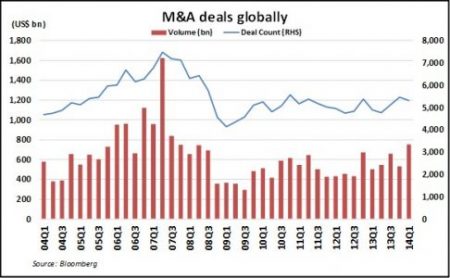M&A activity tends to be cyclical and reasonably predictable. After long periods of relative calm, companies and markets see heightened periods of M&A activity, often prodded on by common underlying drivers. Some of these are: positive change in the economic outlook, rising pile of cash on corporate balance sheets, low interest environments (often artificially low as the current one) and a general increase in risk appetite.
As we entered 2014, the big thematic everybody talked about was a steep pick-up in M&A activity. Call it prescience or smart calling, that theme seems to be playing out in dead earnest. The past two months in particular has seen a spate of deal announcements, on either side of the Atlantic in particular, in quick succession. M&A activity in Q1 2014 has hit levels not seen since end 2007.
Some of these deals are clearly transformational in nature for the acquiring company and will no doubt have a pronounced impact on the industry landscape globally and in particular in certain geographies. Take the Holcim-Lafarge deal as an example. The cement behemoth that will emerge is certain to make the new entity over-powering in Europe, leading surely to certain anti-trust strictures before the deal is approved. Even so, the merger will have multiple repercussions on the global cement industry in many markets where both these companies operate individually today.

In our opinion, there are broadly three key reasons for this enhanced pace of M&A activity.
- Firstly, global growth expectations have stabilised and it appears to be cheaper to just buy an existing operation than to set-up greenfield operations that often take much longer and come with associated execution risks.
- Secondly, US corporations (ex-financials) have piled up a mountain of US$1.6 trillion in cash overseas, much of it across the Atlantic, at the end of 2013. An absence of a tax code for US cash offshore or any amnesty to repatriation of this cash has meant that US corporations have been suffering diminishing or sub-par returns on this ever-growing pile of cash.
- Finally, there has been a rash of activist shareholders running amok increasing pressure on managements to do more with this pile of cash. In a perverse sort of way, having too much cash sitting around has drawn unwanted attention and scrutiny. But perhaps rightly so, that managements have been finally galvanised to do more with the cash as galloping share prices and valuations had begun to make share buy-backs less effective in creating incremental shareholder value.
Besides the above financial considerations, recent deals seem to have a few common threads running through them. For some it is a desire to shed non-core businesses and to focus on core competencies; for others it is to achieve greater cost efficiencies and pricing power. That corporates have had a problem of plenty for some time now in spite of the copious share buy-backs and dividend pay-outs has not been a secret. Based on history therefore it was but a matter of time before we would see enhanced M&A activity
Implications for us
Ideally one wants to be the owner of a company that other people are having a bidding war on. It is very difficult to pin-point such companies. But we remain on the look-out. The good news is that there are a lot of potential M&A assets in Asia which are at distress valuations – the skill is to identify which are of long term sustainable value and which will attrition away. So far, we have marginally benefited via owning bonds in one of the companies recently acquired in Singapore.
On the other hand we do have a larger share of potential acquirers. This is a natural fall out of owning stocks which have strong balance sheets and cash flow. Also, they tend to be in industries with more mature organic growth and hence M&A is a genuine growth option.
In conclusion, inorganic growth (primarily M&A), is a notable source of total expected returns from our equity portfolio.
Idea for the month – Unexpected income-generating assets
One interesting learning over the past month has been how assets we have considered to purely give capital appreciation can also be turned into income generating ones. The example in this case is “Art”. There is an embryonic market of art owners and art renters. The owners could simply be high net worth collectors, but more likely art funds. More interesting is the art renter. They could be hotels, offices, public spaces like airports or hospitals and also individuals. The value add in this business is to build this group of potential renters, be flexible enough to give them a large catalog to choose from, etc.
Increasingly we have even heard of a rental market for luxury goods like high end bags or watches. Again, a unique business model and probably made more viable through cheaper distribution through the internet. In India, where show of jewellery during the wedding season is a social norm, there exists a rental market for wedding jewellery too.
The broad learning is that anything that creates value for people can be rented and does not have to be bought. This obviously creates a broader pool of income generating assets than the conventional sectors that we look at.
End
Disclaimer
This material is not intended as an offer or solicitation for the purchase or sale of any financial instrument. Information has been obtained from sources believed to be reliable. However, neither its accuracy and completeness, nor the opinions based thereon are guaranteed. Opinions and estimates constitute our judgement as of the date of this material and are subject to change without notice. Past performance is not indicative of future results. This information is directed at accredited investors and institutional investors only.
